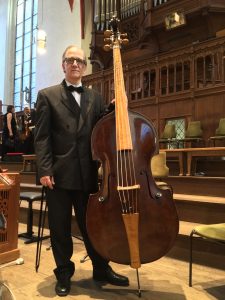This is the bass I presently use full-time. It is a copy of a Viennese bass made in 1748 by Johann Josef Stadlmann. This copy was made in 2012 by Oskar Kappelmeyer in Passau, Germany. Please visit his website for more information: www.oskarkappelmeyer.de

It has five strings as well as frets, and it has a safety string that connects the bridge with the tailpiece. There is no ebony used for the fingerboard or the tailpiece, so despite the considerable size of the instrument (vibrating string length 108.5 cm or 42¾ inches), it is surprisingly lightweight. As for the sound, I only have one word for you: WOW!
I have been trying different strings for the G and D – the instrument originally came with Pure Corde strings, but I found they sounded a bit harsh and lacked roundness in tone. Since then, I have gotten new G and D strings from them in somewhat thicker diameters, and they sound much better. The three lower strings, originally all round-wrapped, were Baldock, and they are just amazing. I have also tried Baldock strings for the G and D, and I think they are also excellent, and I now also have a Baldock plain-gut A string on the instrument, which is a new experience for me. So far, so good! Any other recommendations are very much appreciated – just hit me up via the Contact button!
The tailpiece is attached to the instrument with Kevlar, not steel. This, along with the fact that the tailpiece is not made of ebony, allows the tailpiece to vibrate and transmit the sound from the strings, the way it’s supposed to. This is something I always recommend to students and colleagues whenever I can – the gain in sound is remarkable, and can be as much as 20%. You can also tweak the place the tailpiece occupies – a tiny bit more towards the bridge (about a sixteenth of an inch) will give a more direct sound emission, whereas the other way around, towards the endpin, gives a more diffuse emission.
The bow you see in this picture was made by the late Daniel Latour in 1980. It’s made of snakewood and is fluted along its entire length. The frog is very high – the original bow that served as the model also has this very high frog construction, which was intended for underhand (aka German) use. The original is from the mid-18th century and is in the Uffizi in Florence, Italy. Mine is pretty heavy – 148g or 5¼ oz. – and that weight allows me to handle any kind of musical situation I’m confronted with. The original ivory button of the bow was replaced in 2014 by the excellent French luthier and bowmaker Jean-Yves Tanguy, whose workshop is in Caen. The bow now contains no ivory at all, in accordance with some rather overblown wildlife protection legislation. I have the original ivory button and it is being kept in a safe place, of course!
In the future, I’ll post picture and talk about my other instruments.